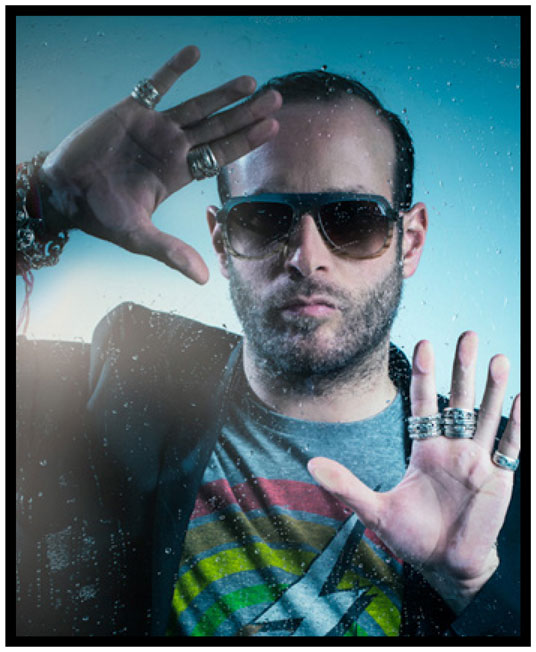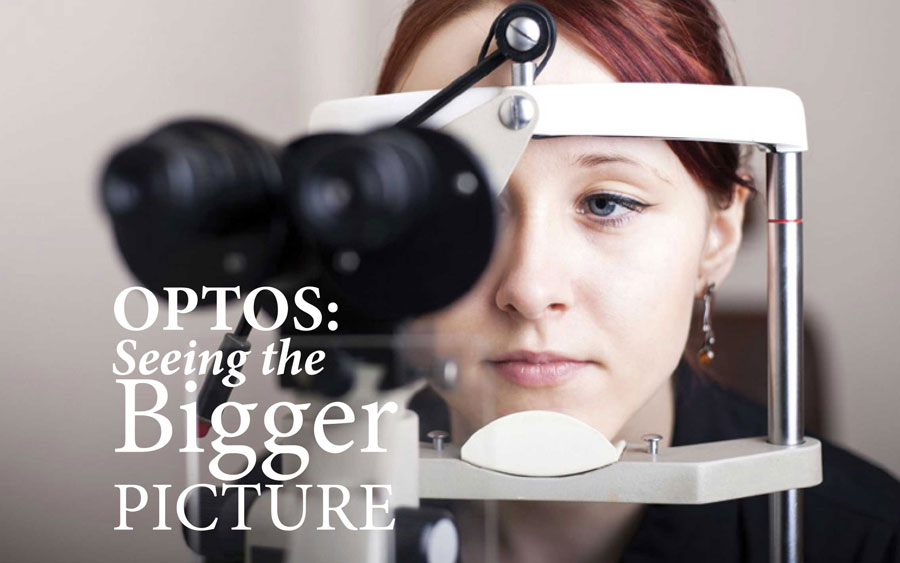By Paddy Kamen

Envision: seeing beyond magazine sent out a call for nominations for men who lead in different sectors of our industry last March. The response was terrific and the nominees were notified in early June. Each one of their stories is truly inspiring. We congratulate these individuals on being nominated by their peers. And the honourees are…..
Category: Designer
Mike Christiansen
Helping people feel great about their appearance is Mike Christiansen’s goal and he achieves that in spades with his optical frame designs.Venus Eye Design is the business founded by Mike and his wife, Brandi, 13 years ago, and he designs all of the company’s eyewear.
“I was working in the industry for other companies and my customers were expressing an interest in frames that no one was creating. I established Venus so I could give them what they wanted. We’ve grown tremendously and six years ago we opened our first eponymous boutique in Edmonton, carrying only Venus brands. We then expanded into Kelowna as a test and, now that we have established the formula with our two stores, we’ll be expanding both nationally and internationally.”
Christiansen must be doing something right to have enjoyed such success. What is his secret?
“I’ve been a strong advocate of colour since I began designing. Once people see what colour can do for them, they love it. Colour makes people happy because it helps to sculpt facial features and enhances eye colour and skin tone. We put our customers in front of the mirror and say ‘look what a bit of colour does for you’. Invariably they say ‘Wow’.”
There’s a strong emotional component to Christiansen’s design aesthetic. “Our product has more value, I believe, because it is based on how it makes a person feel, rather than relying on a logo or current trends. My designs have stood the test of time for over 13 years and not one has been discontinued. We even have people converting from contacts because Venus glasses improve their appearance.”
Word of mouth is the greatest boost to Christiansen’s success. “We have people travelling from Europe to visit our boutiques, because we have a unique offering. Venus has become an international brand name. It is exclusively distributed and not sold just on price,” he says.
Venus has eight collections, most of which are unisex. The latest is Neutrino, launched in June 2013. “It has a lot of bright translucent colours that let light through,” says Christiansen. “They are softer on the skin tone, with a twist of retro styling, emphasizing the 1950s, ‘60s and ‘70s.”
It’s a source of pride for Christiansen that anyone can find the perfect eyewear from one of the Venus collections.
“I don’t think there are many other brands that have created an entire spectrum of product with such buzz and forward thinking as we have. Venus collections cover everyone from the six-month-old infant all the way up through the six-foot-eight guy with the 62 eye size. And we do it all in style. I have focused my brands and lines to fill the gaps in the market. That is why we’re so successful with our boutiques: the whole extended family can walk in and find something. I don’t know of another label that has achieved that.”
Mike Christiansen is indeed a designer of note and his ambition knows no bounds: “I only hope I can continue to accelerate the industry and put Canada on the map internationally,” he says.
Category: Entrepreneur
Francis Jean
Francis Jean loves his people: that is the key point he was eager to make when speaking with Envision: seeing beyond magazine about his nomination for this feature. “There are 1,300 people who work very hard every day to build IRIS The Visual Group and I appreciate their effort so much,” says Jean, the company’s president and CEO.
Well he might, as IRIS is the largest eyecare network of optometrists, opticians and ophthalmologists in Canada, all working under the same brand. “Branding is everything today and the best way to compete in this increasingly difficult industry,” says Jean. “People know and trust the IRIS brand and this only gets stronger with time as we increase our presence in the market. When people ask me what I do for a living, I say, I am a brand builder and I am very passionate about my work.”
The story began in 1986, when Jean opened his first optometry practice in his hometown of Baie-Comeau,QC. He then founded a buying group, engaging several like-minded optometrists who adopted the IRIS trademark in 1990. Since then, IRIS has established itself as the most important branded group of optometrists, opticians and ophthalmologists in the country.
Jean decided on a unique business model, one that creates opportunities for independent eyecare professionals to join IRIS and become participating shareholders. “This was one of the best decisions I have ever made,” he says. “I have seen many joint practice groups fail for lack of strong leadership and internal strife. It is much easier to run a successful business of this size with the structure we have created, one where all 110 owner / partners are intimately involved in various committees and decision-making processes. I take advice well and have nine amazing vice-presidents leading this organization with me.
Everyone is very committed to the success of the company and we become better together.”
With 165 locations across Canada, the proof is in the pudding, as they say. The company promotes collaborative eyecare, bringing optometrists, opticians and ophthalmologists together for the good of the patient.
Three simple values motivate Francis Jean and his team at IRIS: passion, honesty and respect. “We have a strong family culture and we are intent on continuous improvement,” he says. “We track everything in great detail and thus can easily see how everyone on the team ranks. There is a focused effort to learn from the best performers in each area of the business.”
Teamwork extends into Jean’s charitable work, which is hard work indeed. Inspired by his brother Remi’s battle with cancer, Jean has cycled thousands of miles to raise money for cancer research. In 2011, the two brothers and a friend cycled across Canada in 58 weeks. When Envision: seeing beyond magazine caught up with him this summer, he was riding from Vancouver to Jasper, AB, and back, a ride of 2,000 km. These trips have raised almost $200,000 for cancer research.
It’s hard to find a more enthusiastic and energetic entrepreneur than Francis Jean. “I feel 22 years old,” he exclaims. “I’m in great shape!” And, just to make sure I didn’t miss his key point, he adds: “I love my people!”
Category: Leader
Ali Khan
One sure sign of a leader is the ability to bring together people who appear to have very different agendas and align them behind a common purpose. Yavar Ali Khan has done this on both a macro and a micro scale. From his own family to his professional life, Khan is truly a leader.
As one of the founders (along with Dr. Murray Hulbert and Dr. Patrick Quaid) of the Canadian Coalition of Eye Care Professionals (CCEPro), Khan devoted countless hours to its inception and ongoing success. Modeled on the Ontario-based government lobby and consultancy group, the Society of Eye Care Professionals, CCEPro has 1,000 members from across Canada, drawn from optometry, opticianry and ophthalmology. The simple existence of this group is remarkable, given the history of conflict between the professions. The coalition works collaboratively on eyecare issues with the goal of upholding high standards of patient-centered eyecare across Canada.
Khan also brings Canadian optometrists and opticians together through The Khan Group’s Academy of Ophthalmic Education and Optifair trade shows. These events bring continuing education to both professions under the same event umbrella.
Living the proverbial immigrant story, Khan arrived in Canada from Hyderabad,India in 1968 with less than $10 in his pocket. He applied for a job in an optical lab, a position for which he had minimal experience. “I arrived on a Thursday and by Monday I had a job,” he explains. He remains grateful to Dr. Sid Faibish who gave him his first job, and who subsequently recommended that Khan undertake opticianry training. Within five years, his leadership skills became obvious.
When Ryerson University needed to revise its opticianry curriculum in 1976, it turned to Ali Khan. When he finished this task, Ryerson president Walter Pitman gave him a lifetime achievement award in teaching and curriculum development. Pitman also recommended Khan to the Ontario health minister, who appointed him to the Board of Ophthalmic Dispensers in 1979. These distinctions and responsibilities came his way after only a few years in Canada.
Doing his best in everything he undertakes has been Khan’s guiding value throughout his life. On the personal front, he had a responsibility to his family in India when he first arrived here at age 24. “My father was a wealthy industrialist who lost everything during the partition of India in 1947. He died when I was 15 and at that point I undertook to work hard and restore the family to a place of security. I worked with diligence to achieve that goal.”
Khan’s example has rubbed off on his two sons, an optometrist and an optician. Both have served as leaders of their professions.
Charitable fundraising is another area in which Khan shows leadership. He has raised over $100,000 for vision-related charities through the Eye Ball Gala, an occasional event held most recently in Toronto in April 2013.
What will Khan’s legacy be? “I want to help achieve the highest standards of practice and the best possible education for ECPs. I also hope that each profession understands the value of its contribution and that they work together collaboratively for the public good.”
Category: Humanitarian
Claude Chagnon
Claude Chagnon began looking at the world through different coloured glasses about 10 years ago. That’s when he went on his inaugural optical mission to Mexico with a charitable organization called Santa-Cruz. His first big discovery was that he received more than he gave.
“We went to a poverty-stricken region of Mexico. One of my first patients was an old man who was very myopic. He was illiterate and I wondered how improving his vision would help him. He was so excited when he got his new glasses and shared with me that he is a farmer and would now be able to see his cows grazing in the mountains.”
Chagnon, born and raised in Saint-Hyacinthe, QC, was imbued with a helpful spirit from an early age. He credits his parents as an important influence. “I heard my mother say many times, ‘We have to give back what life has given to us.’”
When he was 13, Chagnon needed glasses. His father took him to an ophthalmologist who gave him what Chagnon felt to be a cursory examination. “Then I heard from several of my friends that they went to an optometrist, so I asked my dad if I could go, too,” says Chagnon. “I was impressed with the time the optometrist spent with me, and his explanations of my condition. I decided then and there to become an optometrist and never waivered from that goal.” Studies at the University of Montreal’s School of Optometry led Chagnon to his professional designation at age 23.
The optical mission work began about a decade ago when Chagnon was employed at Costco and the departmental administrator there suggested he consider volunteering. Chagnon says he ‘caught the volunteering virus’ and it has stayed with him ever since. “I saw so many people who, although they were just myopic or hyperopic, could not see, study or read,” he says. “Our work helps them to discover the world. It is like putting on a light in a darkened room.”
The experience transformed him. “I discovered how privileged I am and how easy it is to take our many blessings for granted. Going on an optical mission can really change your values and your perception of modern life. I know I have changed a great deal as a result of this work and I am so thankful for it.”
As Chagnon points out, most poor people in the world don’t have the opportunity to see eyecare professionals. “They can’t afford an eye exam and some people don’t even realize that glasses can help them see better.”
To date, he has travelled to Mexico, Ecuador, Romania ,Morocco, Tunisia and Peru. Like all volunteers with Oeuvre VOSH Santa-Cruz (the organization is now a chapter of VOSH: Volunteer Optometric Services to Humanity), he pays his own airfare plus a $300 donation to the organization on each trip.
“It’s the need that keeps us going back,” he says. “And the people appreciate it so much: they hug and kiss you, and often they cry. It’s very dramatic and heart warming.”
Category: Trailblazer
Alan Ulsifer
Trailblazing requires vision, planning and a lot of plain hard work to hack out a new path. But first it requires motivation and Alan Ulsifer has that in spades.
It was a strong sense of motivation and purpose that led the Saskatoon-raised, Waterloo-trained Ulsifer to the Alberta city of Airdrie to join his first practice in 1990. After four years, he moved to Grand Prairie, a city known for its strong entrepreneurial spirit. There he established a partnership with two other optometrists. They thrived and began opening up locations under the name Northern Vision Centre, which developed into one of Canada’s largest independent optometric practices.
That level of success would have been enough for most professionals, but Ulsifer came up with an even better business concept in 2006.
“I was at the Las Vegas Vision Expo show and I came to understand free-form lenses and the software that created them, and I saw the opportunity to vertically integrate the optometric practice and really create value,” says Ulsifer. “I returned home to Alberta and shared the vision with my partners. We then invited 10 other practices to join us in a two-day meeting to talk about market challenges and opportunities. I didn’t have high expectations but I felt we had to try.”
Everyone at that meeting ‘caught the bug’ and agreed to form a new company; thus, FYidoctors was born. It took about two years to set up the infrastructure and plan, says Ulsifer. “We were now one company and we needed common accounting practices, a new lab and a distribution center,” he notes. “We started our own free-form lab in Burnaby, beginning with a 3,000-square-foot facility. Now we have 10 times that amount of space in a fully robotic lab and exclusive Canadian distribution of 15 products.”
As CEO of FYidoctors, Ulsifer led the largest corporate merger in Canadian history, based on the number of companies involved. How’s that for trailblazing? He was awarded the Ernst and Young Emerging Entrepreneur Award for the Prairie Region in 2008 and the overall Canadian Ernst and Young Entrepreneur Award in 2012.
With 107 practices from the Maritimes to B.C. currently in the fold, FYidoctors is now set on a steady and aggressive course of acquisitions. An Internet-based public portal will soon be launched, with an emphasis on serving existing customers with branded frames and lenses, and new technology that will allow Burnaby-based opticians to do virtual measurements and let the patient shop online for the perfect frame for her specific needs. The online option will be supported by the bricks and mortar locations and vice versa.
What does the word ‘trailblazer’ mean to Alan Ulsifer? “Game changer, sh*t disturber,” he says with a laugh. “Any good business needs to rethink itself and adapt to changing times. I think our team has managed to change the game within an industry that was slow to transform. We have found and continue to find opportunities within the eyecare industry, while always putting patient care first. While I may complain from time to time, I find juggling the many aspects of this business really fun and exciting.”
Spoken like a true trailblazer.
In closing, congratulations to our honourees for service, risk-taking, leading others, creating value and inspiring us all to reach our highest potential!
 Is anyone feeling as much love as Thierry Lasry? The list of celebrities wearing his sunglasses is long indeed, and includes Christina Hendricks, Elle MacPherson, Fergie, Jennifer Lopez, Lady Gaga, Madonna, Alicia Keys and Anne Hathaway. This is just a taste, and surely new names are added daily because Thierry Lasry is the designer to watch.
Is anyone feeling as much love as Thierry Lasry? The list of celebrities wearing his sunglasses is long indeed, and includes Christina Hendricks, Elle MacPherson, Fergie, Jennifer Lopez, Lady Gaga, Madonna, Alicia Keys and Anne Hathaway. This is just a taste, and surely new names are added daily because Thierry Lasry is the designer to watch.









